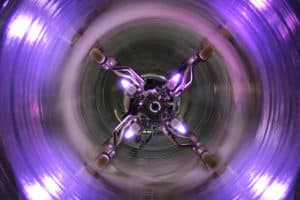What is pipe relining?
Pipe relining is a method that is used to repair a damaged or a partially collapsed drain or sewer pipe without the need of actually replacing the pipe. It is considered that CIPP trenchless-technology minimises any disruption to the area as there is no need to excavate the area that surrounds the damaged pipe.
How does pipe relining work?
Firstly, we use a CCTV drain camera to establish the structural condition of the pipes or sewer and to locate the damaged area. We will then clean the drain or sewer with a high-pressure jet – this is to avoid any damaged areas being hidden by debris or sludge.
We then insert a liner into the pipe, which contains a special resign. Once the liner is inserted into the correct place, it is inflated with air. The next step is to cure the resign in the lining, there are several different methods for this, including UV light, steam, hot water and ambient temperature. Once the resin is cured, it creates a new pipe within the original damaged or broken pipe. Restoring the integrity of the original rain or sewer.
Pipe relining methods
There are three main methods of pipe relining:
This is when UV lighting is used to harden the resin that is found in the lining to create the internal pipe.
- Ambient cure polyester resin
This is when a 2 or 3 part resin system is used when they react with each other they harden and create the internal pipe.
- Heat cured thermosetting resin
This is when hot water or steam is used to harden the resin that is found in the lining to create the internal pipe.
Depending on the sewer or pipe and the environment it’s in, we’ll select the most appropriate pipe relining method.
Pipe relining vs replacement
There are many benefits of pipe relining vs other methods, including:
- Quick installation
It doesn’t take long to set-up the equipment in order to complete the pipe relining procedure. Therefore our professional team is able to work in short time frames. Pipe relining work is the quickest method of fixing a damaged or collapsed pipe.
- No need to excavate
Because there is no need to excavate the area that surrounds the damaged or partially collapsed pipe, there is little disruption to its surroundings. Which means less inconvenience to you and your property.
- Long-lasting
The materials used in the pipe relining procedure is designed to be long-lasting and durable – with a life expectancy of 50 years.
- Good for properties with restricted access
The procedure requires minimal equipment that can be moved easily, compared to other methods, therefore it’s the best choice if your property has restricted access or is positioned in an awkward location.
It’s important to deal with the signs of a damaged or potentially collapsed pipe before it becomes worse. These signs include smelling sewerage, dampness, poor drainage, sewage backup, and subsidence.
Here at UKDN Waterflow, we can provide both domestic pipe relining and commercial pipe relining solutions. If you think your pipe or sewer may be damaged or collapsed, the first step is to get in touch with us and organise a CCTV drain survey to locate the damage and discuss the best way to resolve the issue. If you’d like to find out more about pipe relining methods and the pros and cons of each one, read our parent company’s guide here.
For a sewer or drain pipe relining cost, contact us for a quote using the contact form on the right. Alternatively, you can call us on 0333 344 2937.

